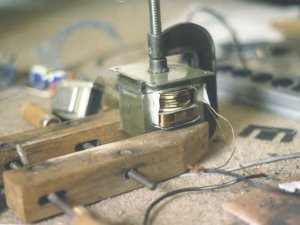
That's right, I made a welder. It's not much, but it works for what little welding of thin steel I occasionally do. Pencil leads - you ask why, how, where and so on? I use them as the tungsten in TIG welding! They don't last too long, but what do you expect, they're only carbon and clay.

A microwave oven transformer, from a rather small oven (it was rated .68kW on the back panel), cut open, then rewound with around 70 turns of 18AWG magnet wire (I got it for free; this is special super heavy wire, the "enamel" can - and has
Of course, alone, this actually has pretty good regulation - this is good if it were a MIG setup, but I'm using it like TIG, where I need bad regulation - a more constant-current characteristic, rather than constant voltage. In addition to that, it makes one hell of a noise if I accidentally short it out - so I need some "softening" resistance.

Since I like magnetics, and I had the spare materials to do it, I used an inductor (a.k.a. choke) to add some AC resistance to the circuit. I could've used a resistor or capacitor just as well, but the cap would need to be very large, and this is more efficient than a resistance (read up on AC theory, and phase relationship...it's complicated, but it explains why the choke only gets mildly warm after a few minutes of welding, whereas a resistor might dissipate as much as 100 watts, which would quickly get very warm).
What I did is glue some paperboard together (just about anything will do fine, I used shoe box), so that the core fits snugly inside it, then wind about 100 turns of 23AWG magnet wire on it - enough to fill it - then soaked it in wax. This secures the turns, quieting it down a bit. Then I fitted the end bells and U-frame on it, and declared it done. Note that I interleaved the core; this increases inductance, at the price of taking 10 minutes to assemble.
The wiring on this is with the choke in series with the primary; at idle (no load) I read 20VAC across the choke, 100V across the primary (100+20= 120V, which is correct), and under a nice smooth arc I read 40V across the choke (secondary voltages are 60V no load, 20V w/arc). I still don't know what the inductance is, so I can't say what value a good resistive substitute would be.
Note that yes, you could also put the limiter in the secondary circuit - it makes no difference. But the resistances will be much smaller (and must be able to handle much more current) for the same amount of "softening".
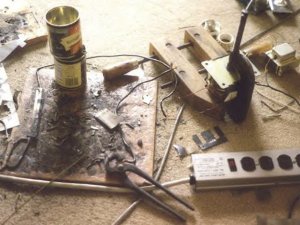
View of the welding area. (Is that the living room carpet? -Lionel) The choke is on the extreme right side; just to the left, the transformer; below, the power strip which I use as power switch; just to the left of that, the nippers which I use to hold the pencil lead (and is connected to the secondary); above and to the left is the blackened aluminum bar I set the work on, as a ground return; above and to the right are some disposable crucibles, made from generic steel cans, with coat hangers welded onto them (the top one still needs the lifting pins).
Surely, the greatest question in all of this must be -- which pencils are the best!? :)
Well, I have tried mostly square carpenter's pencils (I haven't used many "normal" pencils at all), and so far stay very, VERY FAR away from hard. If you can even get them to strike, the arc won't last long. They have much more clay (binder) than graphite (the conductive part), and in short, really, really suck.
Medium hardness seems okay; if you can't get soft, get medium. Soft - the greatest. Minimal clay (I presume), conductive enough, strikes well, burns well, nice welds result.
Important: to prepare the pencils, you must burn off the wood (mmm, cedar - smells good!) and burn out the stuff inside the lead. If you have pilot lights on your stove, perfect. Otherwise...?
Be slow in burning them out. If you heat them too fast, the stuff inside the lead (smells like paraffin wax) can expand too quickly, and pieces of pencil lead will spall off. I deem the leads ready when I've heated the entire length (doesn't need to be hot all at the same time) to redness, this certifies there is no junk left in them.
I suppose if you have a kiln, you could burn out 50 at the same time. 'Course, if you have enough ka-ching for a kiln, and 50 pencils, then you probably already have a welder which has capability much greater than this does. :)
I tried carbon-zinc (remember those?) battery anodes, they really don't work well. They are *too* conductive, and make a mess of the welder. They are difficult to strike, and difficult to hold an arc. I don't think I've ever actually usefully welded anything with them.
As for modifications, as soon as I buy some high amperage diodes I can report on the smooth welding of DC (all I hear about it is good..).
How are the welds? Good, with practice!
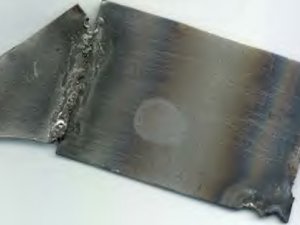
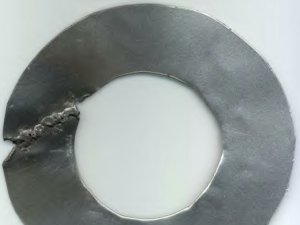
Click for full size photos!
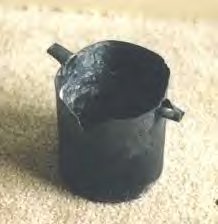
Anything practical yet? You bet!

Unfortunately, it only held up for about 3 melts. :( Not worth the effort, so I use cheap soup cans with lifting tabs tacked on. But at least it [the hole] started in the middle of the steel, not at the welds - so I know that they can hold up to aluminum, at least.
--Tim